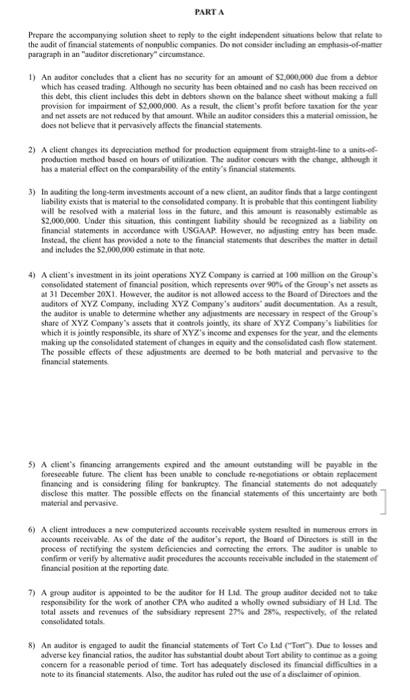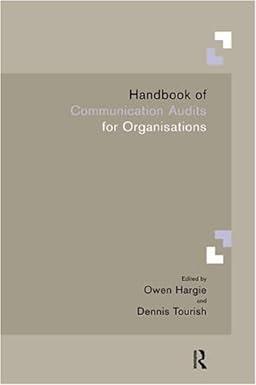PART A Prepare the accompanying solution sheet to reply to the eight independent situation below that related the audit of financial statements of nonpublic companies. Do not consider including an emphasis-of-matter paragraph in an "auditor discretionary circumstance. 1) An soditor concludes that a client has no security for an amount of 52,000,000 due from a debt which has ceased trading. Although no security has been obtained and no cash has been received this debt, this client includes this debt in debtors shown on the balance sheet without making a full provision for impairment of $2,000,000. As a result, the client's profit before taxation for the year and net assets are not reduced by that amount. While an auditor considers this a material omission, de does not believe that it pervasively affects the financial statements 2) A client changes its depreciation method for production equipment from straight line to a units-of- production method based on hours of utilization. The auditor concurs with the change, although it has a material effect on the comparability of the entity's financial statements 3) In auditing the long-term investments account of a new client, an auditor finds that a large contingent liability exists that is material to the consolidated company. It is probable that this contingent liability will be resolved with a material loss in the future and this amount is reasonably estimable as $2,000,000. Under this situation, this contingent liability should be recognised as a liability financial statements in accordance with USGAAP. However, no adjusting entry has been made Instead, the client has provided a note to the financial statements that describes the matter in detail and includes the $2,000,000 estimate in that note 4) A client's investment in its joint operations XYZ Company is carried at 100 million on the Group's consolidated statement of financial position, which represents over 90% of the Group's net assets as 31 December 20X1. However, the auditor is not allowed access to the Board of Directors and the auditors of XYZ Company, including XYZ Company's auditors' audit documentation. As a result, the auditor is unable to determine whether any adjustments are necessary in respect of the Group's share of XYZ Company's assets that it controls jointly, its share of XYZ Company's liabilities for which it is jointly responsible, its share of XYZ's income and expenses for the year, and the elements making up the consolidated statement of changes in equity and the consolidated cash flow statement The possible effects of these adjustments are docted to be both material and pervasive to the financial statements 5) Aclient's financing arrangements expired and the amount outstanding will be payable in the foreseeable future. The client has been able to concludere-negotiations or obtain replacement financing and is considering filing for bankruptcy. The financial statements do not adoquately disclose this matter. The possible effects on the financial statements of this uncertainty are both material and pervasive 6) A client introduces a new computerized accounts receivable system resulted in numerous errors in accounts receivable. As of the date of the auditor's report, the Board of Directors is still in the process of rectifying the system deficiencies and correcting the errors. The auditor is unable to confirm or verify by alternative audit procedures the accounts receivable included in the statement of financial position at the reporting date 7) A group auditor is appointed to be the auditor for H Lid. The group auditor decided not to take responsibility for the work of another CPA who audited a wholly owned subsidiary of Lad. The total assets and revenues of the subsidiary represent 27% and 28%, respectively, of the related consolidated totals 8) An auditor is engaged to audit the financial statements of Tort Co La Cor) Due to losses and adverse key financial ratios, the auditor las substantial doubt about Tortability to contine as a going concern for a reasonable period of time. Tort has adequately disclosed its financial difficulties in a note to its financial statements. Also, the auditor has ruled out the use of a disclaimer of opinion For each of the above situation, assume a) The auditor is independent. b) The auditor previously expressed an unmodified opinion on the prior year's financial statements. c) Only single-year (not comparative) statements are presented for the current year. d) The conditions for an unmodified opinion exist unless contradicted by the facts. c) The conditions stated in the items to be answered are material, unless otherwise indicated Each item to be answered is independent of the others 3) No report modifications are to be made except in response to the factual situation. h) The auditor will not treat a situation as an emphasis of a matter" in what remains an unmodified audit report uniess it is one of those circumstances specifically illustrated in the Professional Standards as an example of a matter an auditor may wish to emphasize. 1) Financial statements of the clients are prepared in according with accounting principles generally accepted in the United States of America. The auditor conduct audit in accordance with auditing standards generally accepted in the United States of America If more than one type of opinion is appropriate, list each one with "Report" and one with "Report 2. For example, if the problem doesn't tell you whether a misstatement pervasively misstates the financial statements or doesn't list a characteristic that indicates pervasiveness, two reports may be possible. If only "Report 1" is appropriate, place an "X" in the "Report 2" Opinion Type cell, which indicates no second type of report is appropriate. Solution Sheet 0 PART A Prepare the accompanying solution sheet to reply to the eight independent situation below that related the audit of financial statements of nonpublic companies. Do not consider including an emphasis-of-matter paragraph in an "auditor discretionary circumstance. 1) An soditor concludes that a client has no security for an amount of 52,000,000 due from a debt which has ceased trading. Although no security has been obtained and no cash has been received this debt, this client includes this debt in debtors shown on the balance sheet without making a full provision for impairment of $2,000,000. As a result, the client's profit before taxation for the year and net assets are not reduced by that amount. While an auditor considers this a material omission, de does not believe that it pervasively affects the financial statements 2) A client changes its depreciation method for production equipment from straight line to a units-of- production method based on hours of utilization. The auditor concurs with the change, although it has a material effect on the comparability of the entity's financial statements 3) In auditing the long-term investments account of a new client, an auditor finds that a large contingent liability exists that is material to the consolidated company. It is probable that this contingent liability will be resolved with a material loss in the future and this amount is reasonably estimable as $2,000,000. Under this situation, this contingent liability should be recognised as a liability financial statements in accordance with USGAAP. However, no adjusting entry has been made Instead, the client has provided a note to the financial statements that describes the matter in detail and includes the $2,000,000 estimate in that note 4) A client's investment in its joint operations XYZ Company is carried at 100 million on the Group's consolidated statement of financial position, which represents over 90% of the Group's net assets as 31 December 20X1. However, the auditor is not allowed access to the Board of Directors and the auditors of XYZ Company, including XYZ Company's auditors' audit documentation. As a result, the auditor is unable to determine whether any adjustments are necessary in respect of the Group's share of XYZ Company's assets that it controls jointly, its share of XYZ Company's liabilities for which it is jointly responsible, its share of XYZ's income and expenses for the year, and the elements making up the consolidated statement of changes in equity and the consolidated cash flow statement The possible effects of these adjustments are docted to be both material and pervasive to the financial statements 5) Aclient's financing arrangements expired and the amount outstanding will be payable in the foreseeable future. The client has been able to concludere-negotiations or obtain replacement financing and is considering filing for bankruptcy. The financial statements do not adoquately disclose this matter. The possible effects on the financial statements of this uncertainty are both material and pervasive 6) A client introduces a new computerized accounts receivable system resulted in numerous errors in accounts receivable. As of the date of the auditor's report, the Board of Directors is still in the process of rectifying the system deficiencies and correcting the errors. The auditor is unable to confirm or verify by alternative audit procedures the accounts receivable included in the statement of financial position at the reporting date 7) A group auditor is appointed to be the auditor for H Lid. The group auditor decided not to take responsibility for the work of another CPA who audited a wholly owned subsidiary of Lad. The total assets and revenues of the subsidiary represent 27% and 28%, respectively, of the related consolidated totals 8) An auditor is engaged to audit the financial statements of Tort Co La Cor) Due to losses and adverse key financial ratios, the auditor las substantial doubt about Tortability to contine as a going concern for a reasonable period of time. Tort has adequately disclosed its financial difficulties in a note to its financial statements. Also, the auditor has ruled out the use of a disclaimer of opinion For each of the above situation, assume a) The auditor is independent. b) The auditor previously expressed an unmodified opinion on the prior year's financial statements. c) Only single-year (not comparative) statements are presented for the current year. d) The conditions for an unmodified opinion exist unless contradicted by the facts. c) The conditions stated in the items to be answered are material, unless otherwise indicated Each item to be answered is independent of the others 3) No report modifications are to be made except in response to the factual situation. h) The auditor will not treat a situation as an emphasis of a matter" in what remains an unmodified audit report uniess it is one of those circumstances specifically illustrated in the Professional Standards as an example of a matter an auditor may wish to emphasize. 1) Financial statements of the clients are prepared in according with accounting principles generally accepted in the United States of America. The auditor conduct audit in accordance with auditing standards generally accepted in the United States of America If more than one type of opinion is appropriate, list each one with "Report" and one with "Report 2. For example, if the problem doesn't tell you whether a misstatement pervasively misstates the financial statements or doesn't list a characteristic that indicates pervasiveness, two reports may be possible. If only "Report 1" is appropriate, place an "X" in the "Report 2" Opinion Type cell, which indicates no second type of report is appropriate. Solution Sheet 0








